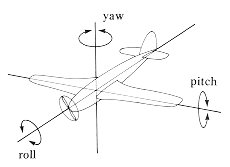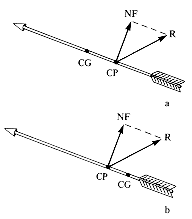| |
Stability
and Control
The motion of an aircraft takes place in three dimensions.
To a reasonable approximation it can be treated as a rigid body. In addition
to the three translation components of the center of mass the plane may
rotate about its center of mass. The diagram shows the names for the component
rotations: roll about the longitudinal axis, yaw about the vertical axis,
and pitch about the horizontal axis. For stable controlled flight the pilot
must be able to control all of these motions.
The resultant of the
aerodynamic forces acts on a different point, the center of pressure. The
design of the aircraft will determine the relative location of the center of
pressure and the center of gravity. The lower diagram shows two cases that yield
different stability behavior. In (a) the center of gravity is in front
of the center of pressure and small yaw or pitch motions produce an aerodynamic
force that tends to restore the system to its initial orientation - an aerodynamically
stable situation. When the center of pressure is in front of the
center of mass, the aerodynamic forces due to small yaw or pitch deflections
increase these deflections and the system is aerodynamically unstable.
|
|
|
|
|
|
|
|
|
|
|
|
|



